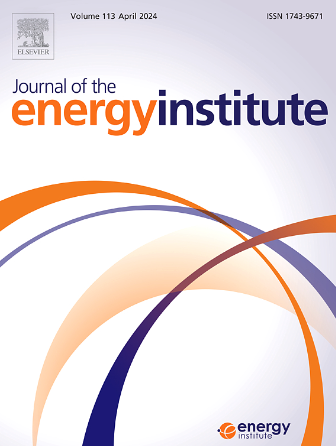Evolutionary behavior of bed materials in oxygen Carrier–Aided combustion of biomass
IF 5.6
2区 工程技术
Q2 ENERGY & FUELS
引用次数: 0
Abstract
The application of oxygen carrier–aided combustion (OCAC), referring to partial or complete substitution of conventional inert bed materials with oxygen carriers (OCs), in a circulating fluidized bed (CFB) offers advantages such as uniform distribution of temperature and oxygen (lattice and gaseous), potentially decreasing CO, CH4, and NO emissions in flue gas. In this study, pine wood chips were employed as the fuel source, while natural hematite was utilized as the OC. The effects of OC proportion (Φ = 25 %, 50 %, 75 %, and 100 %) and air-to-fuel ratio (λ = 1.0 and 1.1) on OCAC performance were evaluated in a 0.5 kWth fluidized bed reactor operated for 30 h. The effects of lattice oxygen (provided by OCs) and gaseous oxygen (in the air) on CO2 yield and combustion efficiency were assessed. The results indicated that the inclusion of OCs significantly decreased CO, CH4, and NO emissions, with CO and CH4 emissions declining by 55.59 % ± 5.32 % and 55.98 % ± 5.96 % respectively, at λ = 1.0, and NO conversion declining from 1.9 % ± 0.18 % (100 wt% SiO2) to 0.89 % ± 0.09 % (50 wt% Fe2O3). The highest CO2 gas yield (89.45 % ± 1.05 %) and combustion efficiency (82.98 % ± 1.22 %) were achieved at λ = 1.1 and Φ = 75 %. Notably, OCAC performance gradually diminished with increased operating time of the CFB boiler, which was attributed to the detrimental effect of biomass ash. The used OC was entirely encased within biomass ash, creating an ash shell structure that blocked OC particle pores and negatively affected gas–solid contact.
氧载体助燃生物质床层物质的演化行为
氧载体辅助燃烧(OCAC)是指在循环流化床(CFB)中用氧载体(OCs)部分或完全替代传统惰性床材料,具有温度和氧气(晶格和气体)均匀分布等优点,有可能减少烟气中CO、CH4和NO的排放。本研究以松木屑为燃料源,天然赤铁矿为OC。在运行30 h的0.5 kWth流化床反应器中,评估了OC比例(Φ = 25%、50%、75%和100%)和空燃比(λ = 1.0和1.1)对OCAC性能的影响。评估了OCAC提供的晶格氧和空气中的气体氧对CO2产率和燃烧效率的影响。结果表明,OCs的加入显著降低了CO、CH4和NO的排放量,在λ = 1.0时,CO和CH4的排放量分别下降55.59%±5.32%和55.98%±5.96%,NO转化率从1.9%±0.18% (100 wt% SiO2)下降到0.89%±0.09% (50 wt% Fe2O3)。当λ = 1.1和Φ = 75%时,CO2产气量达到89.45%±1.05%,燃烧效率达到82.98%±1.22%。值得注意的是,随着循环流化床锅炉运行时间的增加,OCAC性能逐渐下降,这是由于生物质灰的有害影响。使用过的OC被完全包裹在生物质灰中,形成灰壳结构,阻塞OC颗粒孔隙,对气固接触产生负面影响。
本文章由计算机程序翻译,如有差异,请以英文原文为准。
求助全文
约1分钟内获得全文
求助全文
来源期刊

Journal of The Energy Institute
工程技术-能源与燃料
CiteScore
10.60
自引率
5.30%
发文量
166
审稿时长
16 days
期刊介绍:
The Journal of the Energy Institute provides peer reviewed coverage of original high quality research on energy, engineering and technology.The coverage is broad and the main areas of interest include:
Combustion engineering and associated technologies; process heating; power generation; engines and propulsion; emissions and environmental pollution control; clean coal technologies; carbon abatement technologies
Emissions and environmental pollution control; safety and hazards;
Clean coal technologies; carbon abatement technologies, including carbon capture and storage, CCS;
Petroleum engineering and fuel quality, including storage and transport
Alternative energy sources; biomass utilisation and biomass conversion technologies; energy from waste, incineration and recycling
Energy conversion, energy recovery and energy efficiency; space heating, fuel cells, heat pumps and cooling systems
Energy storage
The journal''s coverage reflects changes in energy technology that result from the transition to more efficient energy production and end use together with reduced carbon emission.
 求助内容:
求助内容: 应助结果提醒方式:
应助结果提醒方式:


